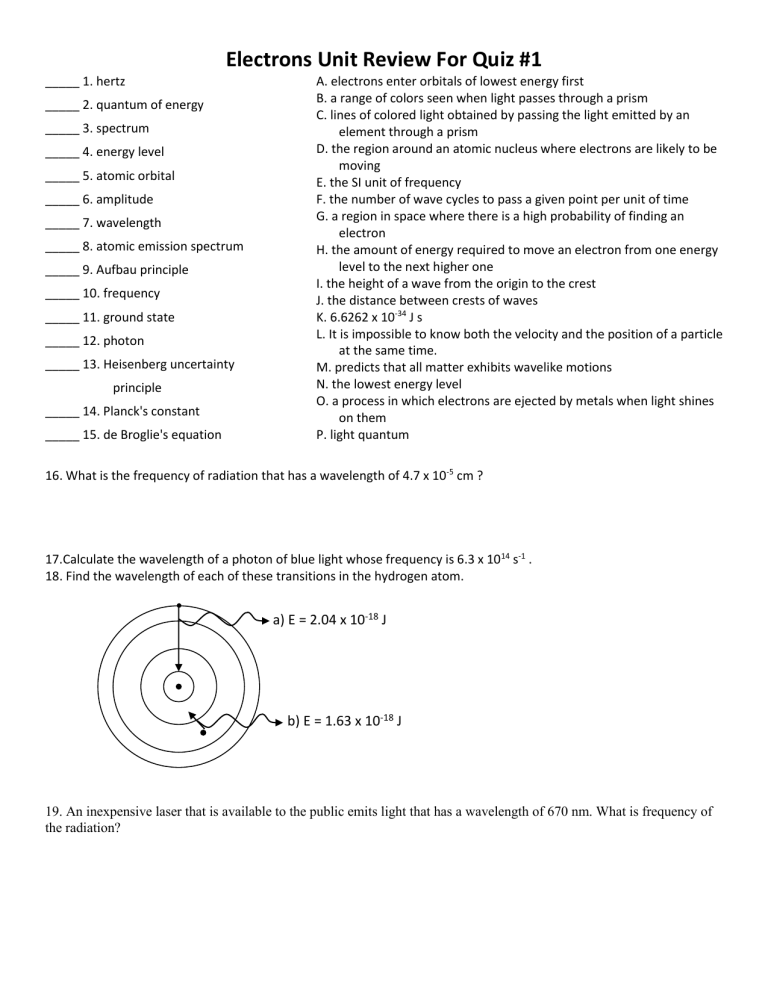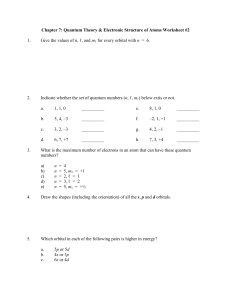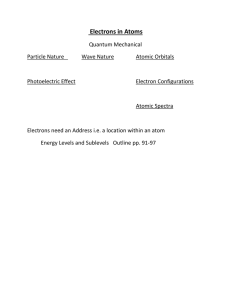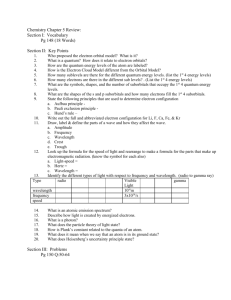
Electrons Unit Review For Quiz #1 _____ 1. hertz _____ 2. quantum of energy _____ 3. spectrum _____ 4. energy level _____ 5. atomic orbital _____ 6. amplitude _____ 7. wavelength _____ 8. atomic emission spectrum _____ 9. Aufbau principle _____ 10. frequency _____ 11. ground state _____ 12. photon _____ 13. Heisenberg uncertainty principle _____ 14. Planck's constant _____ 15. de Broglie's equation A. electrons enter orbitals of lowest energy first B. a range of colors seen when light passes through a prism C. lines of colored light obtained by passing the light emitted by an element through a prism D. the region around an atomic nucleus where electrons are likely to be moving E. the SI unit of frequency F. the number of wave cycles to pass a given point per unit of time G. a region in space where there is a high probability of finding an electron H. the amount of energy required to move an electron from one energy level to the next higher one I. the height of a wave from the origin to the crest J. the distance between crests of waves K. 6.6262 x 10-34 J s L. It is impossible to know both the velocity and the position of a particle at the same time. M. predicts that all matter exhibits wavelike motions N. the lowest energy level O. a process in which electrons are ejected by metals when light shines on them P. light quantum 16. What is the frequency of radiation that has a wavelength of 4.7 x 10-5 cm ? 17.Calculate the wavelength of a photon of blue light whose frequency is 6.3 x 1014 s-1 . 18. Find the wavelength of each of these transitions in the hydrogen atom. a) E = 2.04 x 10-18 J b) E = 1.63 x 10-18 J 19. An inexpensive laser that is available to the public emits light that has a wavelength of 670 nm. What is frequency of the radiation? True-False Classify each of these statements as always true, AT; sometimes true, ST; or never true, NT. ______20. Electrons must have a certain minimum amount of energy called a quantum in order to move from one energy level to the next higher energy level. ______21. The electron probability clouds for atomic orbitals are spherical in shape. ______22. The higher the energy level occupied by an electron the more energetic it is. _____23. The photoelectric effect will occur no matter what frequency of light strikes a metal. _____ 24. The principal quantum number equals the number of sublevels within that principal energy level. _____ 25. The orbitals of a principal energy level are lower in energy than the orbitals in the next higher principal energy level. _____ 26. As many as four electrons can occupy the same orbital. _____ 27. The Pauli exclusion principle states that an atomic orbital may describe at most two electrons. _____ 28. The speed of light is a constant that can be obtained by dividing the frequency of light by its wavelength. _____ 29. The amplitude of a wave is the distance between the crests. _____ 30. The energy of a body can change only in small discrete units. _____ 31. The position and velocity of an electron in an atom can be determined with great certainty. _____ 32. The photoelectric effect will occur no matter what frequency of light strikes a metal. 33. What is the location of an electron with the following quantum numbers a. 4, 1, 0, +1/2 b. 4, 3, -2, -1/2 c. 1, 0, 0. +1/2 d. 3, 2, +1, -1/2 34. Are the following set of quantum numbers possible? If not, why not? a. 2, 1, 0, +1/2 b. 2, 3, -1, -1/2 c. 1, 1, 0, +1/2 d. 5, 2, -3, +1/2 35. What are the quantum number for the following electrons a. 2nd energy level, p sublevel, 3rd orbital , spinning clockwise b. 3rd energy level, s sublevel, 1st orbital, spinning counterclockwise c. 4th energy level, d sublevel, 4th orbital, spinning counterclockwise







